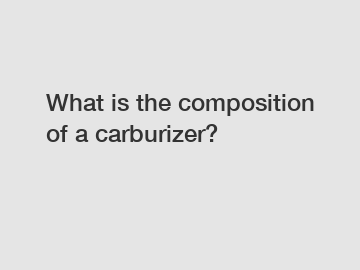What is the composition of a carburizer?
With competitive price and timely delivery, Hengjingming sincerely hope to be your supplier and partner.
What is the Composition of a Carburizer?
Carburizers are additives used in the steelmaking process to increase the carbon content of the metal. But have you ever wondered what exactly is the composition of a carburizer? In this article, we will delve into the constituents of a carburizer, their roles, and the impact they have on the quality of steel. Let's explore!

1. Carbonaceous Materials:
Carburizers primarily consist of various carbonaceous materials. These materials could include petroleum coke, coal tar pitch, anthracite coal, graphite, or even carbon black. The chosen material depends on its carbon content, purity, particle size distribution, and reactivity. These carbonaceous substances are responsible for providing the carbon content required to enhance the steel's properties.
2. Volatile Matter:
In addition to the main carbonaceous materials, carburizers also contain a certain amount of volatile matter. Volatile matter refers to the combustible elements within the carburizer that evaporate or burn off during the steelmaking process. These components typically include hydrogen, nitrogen, oxygen, and sulfur. The proportion of volatile matter affects the overall efficiency of the carburizer and its ability to provide the desired carbon content to the steel.
3. Binders and Additives:
Carburizers often need binders and additives to enhance their performance and ensure uniform distribution within the steel melt. Binders, such as coal tar pitch, act as adhesive materials, helping the carburizer particles stick together and facilitate their incorporation into the liquid steel. Additives, on the other hand, can include antioxidants, fluxes, and desulfurizers, among others. These additional substances aid in the refining process, minimizing impurities and optimizing the steel's quality.
4. Particle Size Distribution:
The particle size distribution plays a crucial role in determining the effectiveness of a carburizer. A broad particle size distribution ensures that the carburizer mixes well with the steel melt, providing a uniform carbon distribution throughout. However, large particles may require additional heat and time to dissolve, affecting the overall efficiency. On the contrary, extremely fine particles might lead to dusting issues and poor handling characteristics. Achieving an ideal particle size distribution is crucial for obtaining desired carbon levels in the steel.
The Impact of Carburizer Composition on Steel Quality:
The composition of a carburizer directly influences the final quality of steel produced. Here's how:
1. Carbon Content Control:
The primary purpose of using a carburizer is to control and increase the carbon content in steel. The chosen carbonaceous material and its carbon content determine the level of carbon enrichment achievable. Controlling the carbon content is crucial as it directly impacts the steel's hardness, strength, and other mechanical properties.
2. Consistency and Uniformity:
An ideal carburizer composition ensures uniform carbon distribution throughout the steel melt, leading to consistent mechanical properties in the final product. Proper mixing, particle size distribution, and carbon content control help achieve this uniformity, resulting in reliable and predictable steel quality.
3. Impurity Reduction:
The presence of additives in the carburizer assists in reducing impurities during the steelmaking process. Fluxes help remove non-metallic inclusions, while desulfurizers ensure the steel contains minimal sulfur content. These additives improve the cleanliness and purity of the steel, enhancing its overall quality and performance.
Conclusion:
The composition of a carburizer is a critical factor in the steelmaking process. Carbonaceous materials, volatile matter, binders, and additives all play significant roles in controlling carbon content, achieving uniformity, and optimizing steel quality. By carefully selecting the composition of a carburizer, steel manufacturers can produce high-quality steel with consistent properties. So, next time you ponder about the composition of a carburizer, remember its importance in shaping the properties of the steel we use every day.
Please visit our website for more information on this topic.
If you are looking for more details, kindly visit Petroleum coke carburizer.



